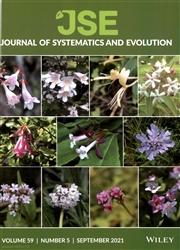Geographic patterns and climatic drivers of phylogenetic structure of liverworts along a long elevational gradient in the central Himalaya
IF 2.9
1区 生物学
Q1 Agricultural and Biological Sciences
引用次数: 0
Abstract
For clades originating in warm climates, the tropical niche conservatism hypothesis predicts that current biological assemblages in colder or drier climates are expected to have lower phylogenetic diversity, and species in colder or drier climates are expected to be more closely related to each other (i.e., higher phylogenetic clustering). Liverworts are one of the oldest clades of extant land plants. They originated about 500 Ma during a warm (“greenhouse”) period and experienced multiple major cycles of warm and cold periods. Here, I test the tropical niche conservatism hypothesis using liverwort assemblages distributed along an elevational gradient crossing about 5000 m of elevation in the central Himalaya. I found that, in general, phylogenetic diversity and dispersion decrease with increasing elevation and thus with decreasing temperature, which is consistent with the tropical niche conservatism hypothesis. Phylogenetic diversity decreases with elevation monotonically, but phylogenetic dispersion decreases with elevation in a triphasic (zig‐zag) pattern, which is generally consistent with the triphasic pattern found in angiosperms and polypod ferns along the same elevational gradient. Temperature‐related variables explained approximately the same amount of the variation in phylogenetic diversity and dispersion as did precipitation‐related variables, although mean annual temperature explained 9%−15% more variation than did annual precipitation. Climate extreme variables explained approximately the same amount of variation in phylogenetic diversity and dispersion as did climate seasonality variables.喜马拉雅山中部漫长海拔梯度上肝草系统发育结构的地理模式和气候驱动因素
对于起源于温暖气候的支系,根据热带生态位保守性假说的预测,目前在较寒冷或较干旱气候条件下的生物组合的系统发育多样性较低,而在较寒冷或较干旱气候条件下的物种之间的亲缘关系较近(即系统发育聚类较高)。肝草属植物是现存陆生植物中最古老的类群之一。它们起源于约 500 Ma 的温暖("温室")时期,并经历了多个主要的冷暖周期。在这里,我利用分布在喜马拉雅山脉中部海拔约 5000 米的海拔梯度上的肝草群来验证热带生态位保守性假说。我发现,一般来说,系统发育多样性和分散性会随着海拔的升高而降低,因此也会随着温度的降低而降低,这与热带生态位保守性假说是一致的。系统发育多样性随着海拔的升高而单调降低,但系统发育的分散性随着海拔的升高而呈三相(之字形)模式降低,这与被子植物和多足蕨类植物在同一海拔梯度上发现的三相模式基本一致。温度相关变量与降水相关变量对系统发育多样性和分散性变化的解释大致相同,但年平均气温对变化的解释比年降水量多 9%-15%。气候极端变量与气候季节性变量对系统发育多样性和分散性变异的解释量大致相同。
本文章由计算机程序翻译,如有差异,请以英文原文为准。
求助全文
约1分钟内获得全文
求助全文
来源期刊

Journal of Systematics and Evolution
Agricultural and Biological Sciences-Ecology, Evolution, Behavior and Systematics
CiteScore
7.40
自引率
8.10%
发文量
1368
审稿时长
6-12 weeks
期刊介绍:
Journal of Systematics and Evolution (JSE, since 2008; formerly Acta Phytotaxonomica Sinica) is a plant-based international journal newly dedicated to the description and understanding of the biological diversity. It covers: description of new taxa, monographic revision, phylogenetics, molecular evolution and genome evolution, evolutionary developmental biology, evolutionary ecology, population biology, conservation biology, biogeography, paleobiology, evolutionary theories, and related subjects.
 求助内容:
求助内容: 应助结果提醒方式:
应助结果提醒方式:


